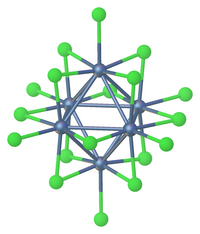Tantalum(III) chloride
| Names | |
|---|---|
| Other names
tantalum trichloride
| |
| Identifiers | |
3D model (JSmol)
|
|
| ChemSpider | |
| ECHA InfoCard | 100.033.611 |
| EC Number |
|
PubChem CID
|
|
CompTox Dashboard (EPA)
|
|
| |
| |
| Properties | |
| Cl3Ta | |
| Molar mass | 287.30 g·mol−1 |
| Appearance | black-green |
| Melting point | 440 °C (824 °F; 713 K) decomposes[1] |
| yes | |
| Related compounds | |
Other anions
|
Tantalum(III) bromide Tantalum(III) iodide |
Other cations
|
Niobium(III) chloride |
Related compounds
|
Ta6Cl15 Tantalum(IV) chloride Tantalum(V) chloride |
Except where otherwise noted, data are given for materials in their standard state (at 25 °C [77 °F], 100 kPa).
| |
Tantalum(III) chloride or tantalum trichloride is non-stoichiometric chemical compound with a range of composition from TaCl2.9 to TaCl3.1[2] Anionic and neutral clusters containing Ta(III) chloride include [Ta6Cl18]4− and [Ta6Cl14](H2O)4.[3]

Formation
[edit]Tantalum(III) chloride is formed by reducing tantalum(V) chloride with tantalum metal. this is done by heating tantalum(III) chloride to 305 °C, passing the vapour over tantalum foil at 600°, and condensing the trichloride at 365 °C. If the condensing region is kept at too high a temperature, then TaCl2.5 deposits instead.[5]
The trichloride can also be prepared by thermal decomposition of TaCl4, with removal of volatile TaCl5. TaCl5 can be vapourised leaving behind TaCl3.[6]
"Salt-free reduction" of a toluene solution of TaCl5 with 1,4-disilyl-cyclohexadiene in the presence of ethylene produces a complex of TaCl3:[7]
- TaCl5 + C6H6(SiMe3)2 → TaCl3 + C6H6 + 2 Me3SiCl
Properties
[edit]Above 500 °C, TaCl3 disproportionates further releasing TaCl5.[6] TaCl3 is insoluble in room temperature water, or dilute acid, but dissolves in boiling water. A blue-green solution is formed.[6]
Complexes
[edit]Tantalum(III) chloride can form complexes with some ligands as a monomer or dimer.
Complexes include Ta(=C-CMe3)(PMe3)2Cl3, [TaCl3(P(CH2C6H5)3THF]2μ-N2 and [TaCl3THF2]2μ-N2 (dinitrogen complexes).[8]
As a dimer, complexes include Ta2Cl6(SC4H8)3 (SC4H8=tetrahydrothiophene). Ta2Cl6(SMe2)3, Ta2Cl6(thiane)3 and Ta2Cl6(thiolane)3 have a double bond between the two tantalum atoms, and two bridging chlorides, and a bridging ligand.[7]
References
[edit]- ^ Haynes, William M. (2016). CRC Handbook of Chemistry and Physics (97 ed.). CRC Press. pp. 4–97. ISBN 978-1-4987-5429-3.
- ^ Cotton, F Albert; Wilkinson, Geoffrey (1966). Advanced Inorganic Chemistry A Comprehensive Text. John Wiley. p. 927.
- ^ Duraisamy, Thirumalai; Hay, Daniel N. T.; Messerle, Louis (2014). "Octahedral Hexatantalum Halide Clusters". Inorganic Syntheses: Volume 36. Vol. 36. pp. 1–8. doi:10.1002/9781118744994.ch1. ISBN 9781118744994.
- ^ Thaxton, C. B.; Jacobson, R. A. (1971). "The Crystal Structure of H2(Ta6Cl18)(H2O)6". Inorganic Chemistry. 10 (7): 1460–1463. doi:10.1021/ic50101a029.
- ^ Gutmann, Viktor (2012). Halogen Chemistry. Elsevier. p. 158. ISBN 978-0-323-14847-4.
- ^ a b c Remy, Heinrich (1963). Treatise on Inorganic Chemistry: Sub-groups of the periodic table and general topics. Elsevier Publishing Company. p. 115.
- ^ a b Tsurugi, Hayato; Mashima, Kazushi (2019). "Salt-Free Reduction of Transition Metal Complexes by Bis(trimethylsilyl)cyclohexadiene, -dihydropyrazine, and -4,4′-bipyridinylidene Derivatives". Accounts of Chemical Research. 52 (3): 769–779. doi:10.1021/acs.accounts.8b00638. PMID 30794373. S2CID 73505603.
- ^ Churchill, Melvyn Rowen.; Wasserman, Harvey J. (1982). "The Ta(μ-N2)Ta System. 2. Crystal Structure of [TaCl3(P(bz)3)(THF)]2(μ-N2).≈0.7CH2Cl2. A Binuclear Di-imido Complex of Octahedral Tantalum(V)". Inorganic Chemistry. 21 (1): 218–222. doi:10.1021/ic00131a040.
